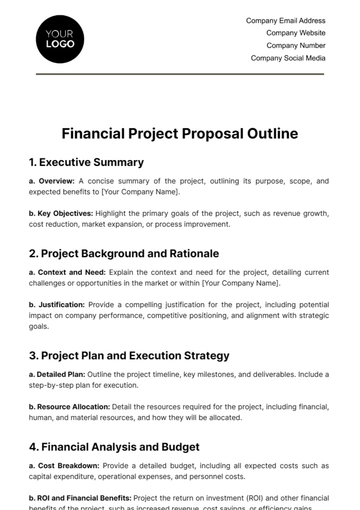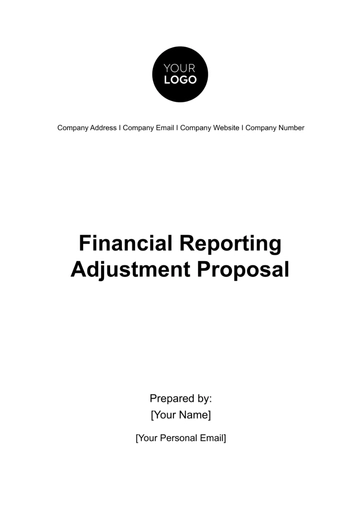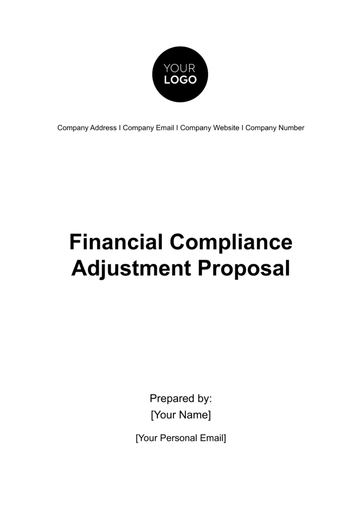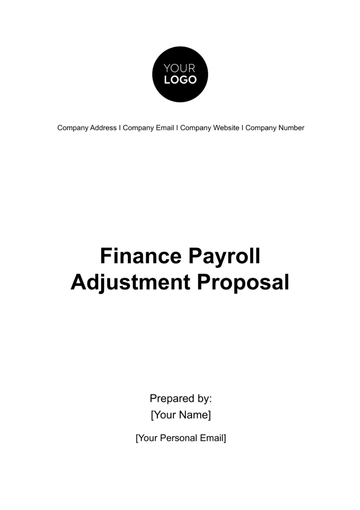Free Finance Payroll Adjustment Proposal
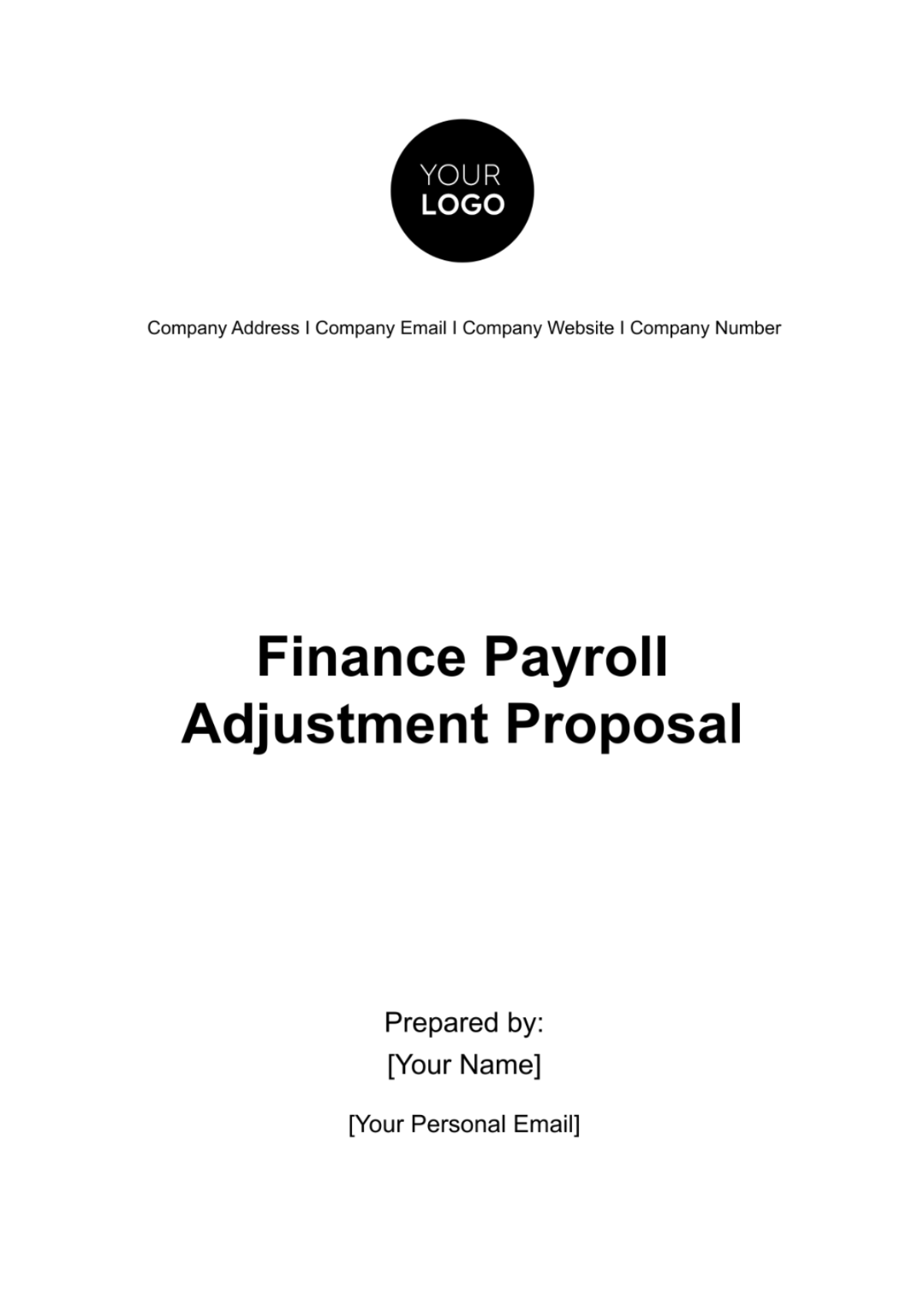
Introduction
This document presents a comprehensive proposal for adjusting our organization's finance payroll system. The proposal aims to address current operational challenges, optimize payroll management, and align with our strategic financial goals. This adjustment is envisioned to streamline payroll processes, ensuring efficiency, accuracy, and compliance with regulatory standards.
Purpose and Objectives
The primary purpose of this payroll adjustment is to enhance the effectiveness and reliability of our payroll system. The objectives include:
Reducing errors in payroll calculations and processing times.
Identifying and implementing strategies to minimize payroll-related expenses.
Ensuring our payroll system adheres to the latest legal and tax requirements.
Streamlining the payroll process to ensure timely and accurate salary disbursement, thereby improving employee morale.
Background for Adjustment
In the past year, we have observed several challenges with our current payroll system:
Inefficiency and Errors: A noticeable rate of errors in payroll calculations was observed, leading to an increased workload in rectifying these issues.
Regulatory Challenges: Recent changes in tax laws and employment regulations have made our current system less compliant, posing potential legal risks.
Cost Overruns: Analysis revealed that our payroll processing costs have exceeded the budget by 15% in the past fiscal year, indicating a need for cost-effective solutions.
Employee Feedback: Surveys conducted among employees highlighted delays and inaccuracies in salary payments, affecting overall job satisfaction.
These challenges necessitate a thorough review and adjustment of our finance payroll system to ensure it meets our operational needs, financial objectives, and the well-being of our workforce.
Current Payroll System Analysis
This section provides an in-depth analysis of our existing payroll system, highlighting its structure and functionality. It critically examines the current system to identify key issues and their impacts on both the organization and our employees.
The Existing Payroll System
Our current payroll system is a semi-automated process that relies on both software tools and manual interventions. Employee data, including hours worked, leaves, and other variables, are initially inputted manually into the system. The software then calculates the gross pay, deductions (such as taxes, insurance, and retirement contributions), and arrives at the net pay. However, final checks and adjustments are often done manually. The system also handles year-end tax documentation and compliance reporting. While it integrates with our human resources management system, it lacks real-time data synchronization, leading to delays and discrepancies in information flow.
Issues and Impacts
Issue | Impact |
High reliance on manual interventions for data input and verification. | Manual processes are prone to human error, leading to incorrect payroll calculations. This affects employee trust and satisfaction. |
Lack of real-time integration with other systems, such as HR and timekeeping. | Results in delays in processing payroll, affecting the timeliness of salary disbursement to employees. |
The existing software lacks advanced features like automatic tax updates and real-time analytics. | Puts the organization at risk of non-compliance with changing tax laws and regulations, potentially leading to legal and financial penalties. |
Inadequate reporting features for strategic decision-making and financial planning. | Hampers the organization’s ability to make informed decisions and plan for financial contingencies effectively. |
Proposed Payroll Adjustments
This section outlines the specific adjustments proposed for our finance payroll system. Each proposed change is detailed below, along with its justification and the way it addresses the issues identified in the current system.
Proposal | Justification | Rationale |
Implementation of a Fully Automated Payroll System | Automating the payroll process reduces the likelihood of human error, leading to more accurate and timely payroll processing. | Addresses manual data entry errors and delays in data synchronization by automating the entire process. |
Real-Time Data Integration | Integrating payroll with HR and timekeeping systems in real time ensures up-to-date data, reducing processing delays. | Solves the issue of delayed data synchronization, ensuring timely and accurate payroll processing. |
Upgrading to Advanced Payroll Software | Advanced software with automatic updates for tax laws and regulations ensures compliance and reduces legal risks. | Addresses the compliance risk by ensuring the payroll system is always up-to-date with the latest tax laws and regulations. |
Enhanced Reporting and Analytics Features | Improved analytics and reporting capabilities aid in better financial planning and decision-making. | Tackles the limitation of strategic decision-making due to inadequate reporting in the current system. |
Cost Optimization Strategies | By automating and streamlining the process, the overall costs of payroll processing are reduced. | Directly addresses the financial burden issue by making the payroll process more cost-effective compared to the current system. |
Financial Implications
This section delves into the financial aspects of the proposed payroll adjustments, providing a detailed cost analysis and highlighting the potential savings and financial benefits. Additionally, it discusses the budget considerations and funding sources required to implement these adjustments.
Cost Analysis
Proposed Adjustment | Estimated Cost | Annual Operating Cost |
Fully Automated Payroll System | $50,000 | $10,000 |
Real-Time Data Integration | $20,000 | $5,000 |
Advanced Payroll Software Upgrade | $30,000 | $7,000 |
Enhanced Reporting and Analytics | $15,000 | $3,000 |
Cost Optimization Strategies | $10,000 | $2,000 |
Potential Savings
The implementation of these adjustments is expected to yield significant financial benefits:
Estimated annual savings of $8,000 from reduced error rectification.
Streamlining processes could save up to $15,000 annually in operational costs.
Anticipated reduction in compliance-related penalties and legal fees by approximately $5,000 annually.
Budget Considerations
Budget | Amount | Source |
Initial Implementation | $125,000 | Reallocation from the existing IT and HR budget |
Annual Operation | $27,000 | Annual operational budget with adjustments |
Contingency | $20,000 | Reserve funds |
Implementation Plan
This section outlines a detailed plan for implementing the proposed payroll system adjustments. It specifies the key steps involved, the timeline for each step, and the responsibilities assigned to ensure a smooth transition.
Steps | Month | Responsibility |
Initial System Assessment and Requirements Gathering | Month 1 | IT Department and HR Management |
Selection and Procurement of | Month 2-3 | IT Department and Procurement Team |
Development and Testing of | Month 4-5 | IT Development Team |
Installation and Configuration of | Month 6 | IT Department and Software Vendor |
Training Sessions for HR and Payroll Staff | Month 7 | HR Management and External Trainers |
Pilot Testing of New System with | Month 8 | HR Department and Pilot Group |
Full Implementation of | Month 9 | HR and IT Departments |
Monitoring and Feedback Collection | Month 10 | HR Department and Quality Assurance Team |
Risk Assessment and Methodologies
This section identifies potential risks associated with the implementation of the new payroll system and outlines corresponding mitigation strategies. It aims to proactively address challenges to minimize disruptions and ensure a successful transition.
Risk | Likelihood | Impact | Mitigation Strategy |
Technical Issues with New System | Medium | High | Implement a thorough testing phase during development; establish a technical support team for immediate response to issues. |
Employee Resistance to Change | Low | Medium | Conduct training sessions; provide clear communication about benefits and support during transition. |
Data Security Risks | High | High | Employ robust cybersecurity measures; regular security audits and compliance checks. |
Project Delays | Medium | Medium | Develop a detailed project timeline with buffer periods; regular progress reviews and contingency plans for delays. |
Cost Overruns | Low | High | Maintain strict budget monitoring; regular financial reviews and adjustments as necessary. |
Compliance and Legal Issues | Low | High | Engage legal experts for compliance checks; regular updates on legal and regulatory changes. |
Inaccurate Data Transfer | Medium | High | Ensure accurate data migration through validation checks; involve data specialists in the transfer process. |
Legal and Compliance Considerations
This section outlines the legal and compliance considerations relevant to our payroll system adjustments in the United States. It ensures that the proposed changes align with applicable laws and regulations, and details the procedures we will adopt to maintain compliance post-implementation.
Relevant US Laws
Fair Labor Standards Act (FLSA): The proposed system will ensure accurate tracking and compensation for overtime, adhering to FLSA requirements. Automated timekeeping will enhance compliance with minimum wage and overtime pay standards.
Internal Revenue Service (IRS) Regulations: With advanced software, we will ensure accurate tax deductions and record-keeping, in line with IRS guidelines. The system will automatically update for any changes in tax laws, ensuring ongoing compliance.
Employee Retirement Income Security Act (ERISA): The new payroll system will maintain precise records of employee benefits and retirement plans, complying with ERISA’s reporting and disclosure requirements.
Health Insurance Portability and Accountability Act (HIPAA): In handling employee health benefit information, the system will comply with HIPAA’s privacy and security rules, ensuring the confidentiality and integrity of sensitive data.
Equal Employment Opportunity (EEO) Laws: By ensuring unbiased and transparent payroll processing, the system supports compliance with EEO laws, preventing discrimination in compensation.
Compliance Post-Implementation
Staying informed on legislative changes affecting payroll and adjusting the system accordingly.
Conducting periodic audits to ensure ongoing adherence to legal standards and identifying areas for improvement.
Regular training sessions for staff to update them on compliance-related changes and system use.
Maintaining detailed records of all payroll transactions and reports for legal scrutiny and audits.
Regularly updating security measures to protect sensitive payroll data, in compliance with data protection laws.
Employee Communication and Training
This section focuses on the strategies for effectively communicating the upcoming changes to our employees and outlines the comprehensive training programs planned for staff adaptation to the new payroll system. It also presents the mechanisms we will implement to gather feedback throughout this transition process.
Employee Communication
Initial Announcement Email: An all-staff email detailing the upcoming changes, reasons for the shift, and expected benefits.
Information Sessions: Organized departmental meetings to explain the changes in detail and address immediate concerns.
Q&A Sessions: Interactive sessions for employees to ask questions and get clarifications about the new system.
Direct Line of Communication: Establishing a dedicated email and phone line for ongoing questions and support.
Staff Training Programs
Training Topic | Target Audience | Duration | Method |
Overview of New Payroll System | All Employees | 1 Hour | Webinar |
Detailed System Functionality | HR and Payroll Staff | 2 Days | In-Person Workshop |
Data Entry and Processing | Administrative Staff | 3 Hours | Online Tutorial |
Advanced Features and Reporting | Management Staff | 4 Hours | Interactive Session |
Security Protocols | IT and HR Teams | 2 Hours | Seminar |
Feedback Mechanisms
Post-Training Surveys
Suggestion Box
Follow-Up Meetings
Performance Metrics
Employee Satisfaction Surveys
- 100% Customizable, free editor
- Access 1 Million+ Templates, photo’s & graphics
- Download or share as a template
- Click and replace photos, graphics, text, backgrounds
- Resize, crop, AI write & more
- Access advanced editor
The Finance Payroll Adjustment Proposal Template from Template.net is an indispensable tool for proposing changes to payroll systems. Editable and customizable in our AI Editor tool, it allows for detailed presentations of proposed payroll adjustments. This template streamlines the process of suggesting and reviewing payroll changes, ensuring clear communication and efficient decision-making in any financial or HR department.
You may also like
- Business Proposal
- Research Proposal
- Proposal Request
- Project Proposal
- Grant Proposal
- Photography Proposal
- Job Proposal
- Budget Proposal
- Marketing Proposal
- Branding Proposal
- Advertising Proposal
- Sales Proposal
- Startup Proposal
- Event Proposal
- Creative Proposal
- Restaurant Proposal
- Blank Proposal
- One Page Proposal
- Proposal Report
- IT Proposal
- Non Profit Proposal
- Training Proposal
- Construction Proposal
- School Proposal
- Cleaning Proposal
- Contract Proposal
- HR Proposal
- Travel Agency Proposal
- Small Business Proposal
- Investment Proposal
- Bid Proposal
- Retail Business Proposal
- Sponsorship Proposal
- Academic Proposal
- Partnership Proposal
- Work Proposal
- Agency Proposal
- University Proposal
- Accounting Proposal
- Real Estate Proposal
- Hotel Proposal
- Product Proposal
- Advertising Agency Proposal
- Development Proposal
- Loan Proposal
- Website Proposal
- Nursing Home Proposal
- Financial Proposal
- Salon Proposal
- Freelancer Proposal
- Funding Proposal
- Work from Home Proposal
- Company Proposal
- Consulting Proposal
- Educational Proposal
- Construction Bid Proposal
- Interior Design Proposal
- New Product Proposal
- Sports Proposal
- Corporate Proposal
- Food Proposal
- Property Proposal
- Maintenance Proposal
- Purchase Proposal
- Rental Proposal
- Recruitment Proposal
- Social Media Proposal
- Travel Proposal
- Trip Proposal
- Software Proposal
- Conference Proposal
- Graphic Design Proposal
- Law Firm Proposal
- Medical Proposal
- Music Proposal
- Pricing Proposal
- SEO Proposal
- Strategy Proposal
- Technical Proposal
- Coaching Proposal
- Ecommerce Proposal
- Fundraising Proposal
- Landscaping Proposal
- Charity Proposal
- Contractor Proposal
- Exhibition Proposal
- Art Proposal
- Mobile Proposal
- Equipment Proposal
- Student Proposal
- Engineering Proposal
- Business Proposal








